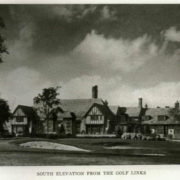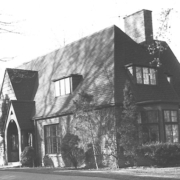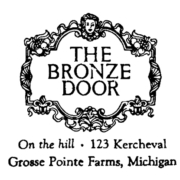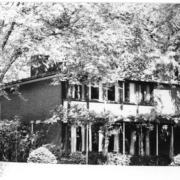Historical Architecture of Grosse Pointe – The Country Club of Detroit
Last week we concluded our two-part feature on the Grosse Pointe Yacht with a presentation on the design of the club house, from the ornate exterior to the splendid Italian influenced interior. Upon completion on July 4, 1929, it was one of the finest yacht clubs in America. This week we bring our exploration of Grosse Pointe Clubs to a close as we focus on the Country Club of Detroit. The current building was designed by the prestigious Detroit firm of Smith, Hinchmann, and Grylls. It opened in 1927.
Prior to the completion of the new clubhouse the history of the Country Club of Detroit (CCD) dates to 1886, when the original building was completed. The club hired architect William E. Brown to design a clubhouse that would be situated on the shores of Lake St. Clair on a scenic seven-acre site. However, two years after completion, the clubhouse was forced to close due to membership issues. Despite being popular with residents the poorly maintained roads from Detroit to Grosse Pointe made the club difficult to access. By the late 1880’s transport links with Detroit were vastly improved and the club became more accessible – it reopened under the name of the Country Club of Detroit (having been originally known as the Grosse Pointe Club). Image courtesy of: Library of Congress.
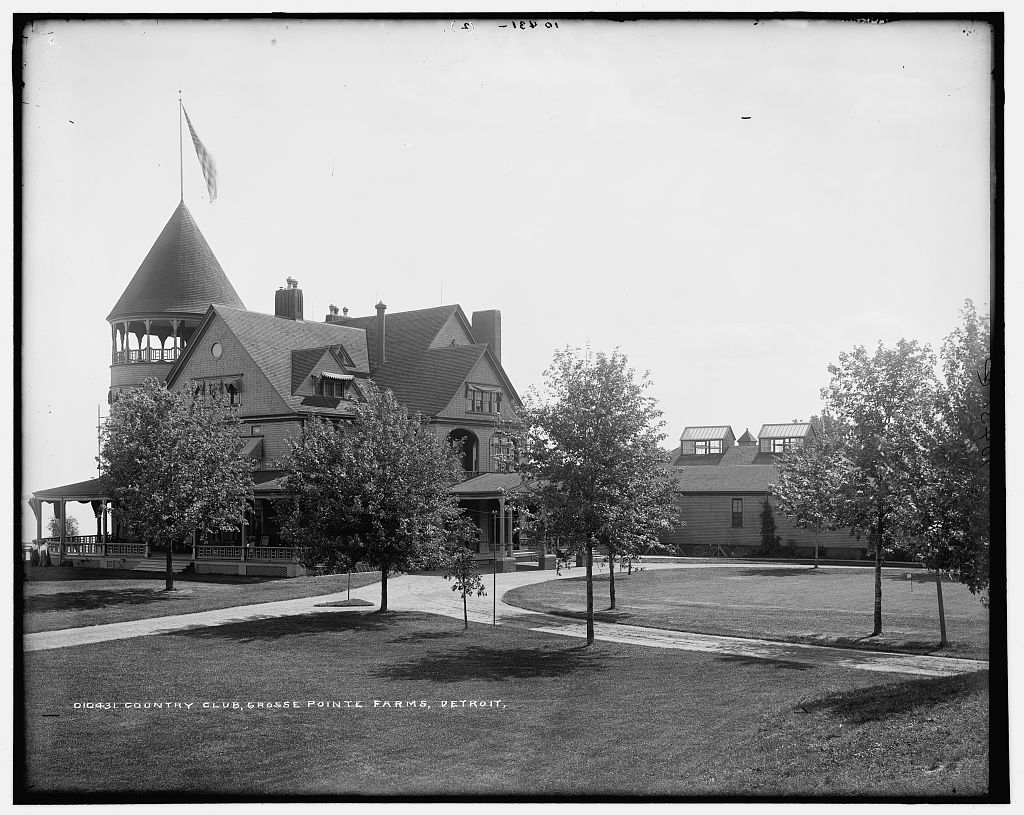
By the early 20th century, the number of year-round residents in Grosse Pointe had increased substantially, and more permanent homes were being built. The Country Club of Detroit was fast becoming the social center of the Grosse Pointe community and had become a year-round organization. It was decided a larger more modern clubhouse was needed. The club hired Albert Kahn to design a brick building on part of the original site. Completed in 1907, the new four-story building, located at 12 Lakeshore Dr, was superb, close in style to some of Kahn’s residential projects of that era. It is reported the building cost approximately $60,000 to build (around $1.9m today). Image courtesy of: Library of Congress.
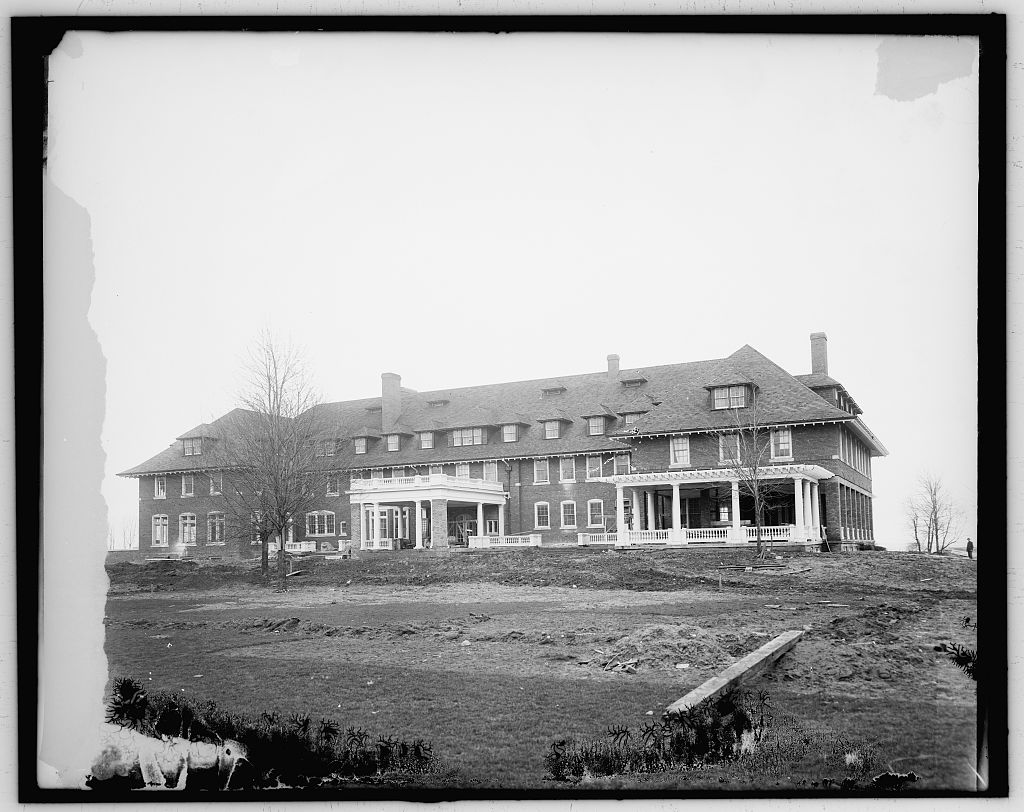
In 1912 the club was continuing to expand. As demand for land in Grosse Pointe continued to grow, and because the lease on the Joseph Berry property (the location of the golf course close to the original clubhouse) was not going to be renewed the club made the decision to purchase land for its own golf course or run the risk of losing it. In 1912, the CCD purchased Weir Farm – the home of its present location – and hired renowned British golf architect Harry Colt to design their new course on the former farmland. Source http://www.ccofd.com. You can read the full story of the CCD golf course by clicking here. And the full history of the two earlier country clubs by clicking here.
In 1921 CCD members voted to relocate the club, to its present site, 220 Country Club Drive, close to the golf course – and sell the lakefront property, which officially closed on June 10, 1923. Albert Kahn was hired once again to design the new clubhouse. Kahn created the building in an English Cottage style. It was constructed from brick and featured many artistic details on the exterior of the building. On July 4, 1923, the clubhouse opened its doors to the members at a cost of $450,000 (around $7.8m today). However, two years later, on October 18, 1925, the building was destroyed after a fire broke out above the second floor and spread through the building; only the kitchen wing was left intact. Source: www.ccofd.com. After taking the decision to rebuild, the club hired Smith, Hinchman, a Grylls to design their new clubhouse.
Smith, Hinchman, and Grylls (SHG), during the early twentieth century, had established a stellar reputation in Detroit for designing large commercial and civic projects. At the time, the firm employed some of the finest architects of the era. Aside from creating a multitude of grand residences throughout Metro Detroit they were also responsible for designing iconic buildings such as –
- Crowleys Department Store (Detroit 1906)
- Hudsons Department Store (Detroit 1911)
- The Bankers Trust Company Building (Detroit 1925)
- The Buhl Building (Detroit 1925)
- Guardian Building (Detroit 1928)
At the time it is reported the Country Club of Detroit had around 700 members. When designing the new club house, SHG opted to retain much of the traditional Tudor Revival style, however the layout and details were very different to the previous building. Given the number of members, the clubhouse needed to be large enough to accommodate multiple function rooms and provide enough space for the growing list of facilities the club wanted to provide. At the time of completion, the clubhouse was one of the most impressive in Metro Detroit – it had cost $650,000 (around $11m today) to build. Given that the Grosse Pointe Club (in 1927) cost close to $225,000 (around $3.8m today) it shows the magnitude of the project.
The building was constructed from pressed brick, timber, plaster with a distinctive variegated slate roof – a fundamental part of Tudor Revival architecture during this era.Inside, the materials used throughout were predominantly stone, plaster, hewed oak, tile, and brick. The floors throughout the clubhouse were oak and teak plank, stone, slate, and tile. The main floor featured several large rooms and a long connecting gallery. From the gallery members could access the great hall, the living room, and the main lounge. Also on the first floor was several small lounges, the dining room, the service wing, and the large terrace at the rear of the building that overlooked the golf course. Photos courtesy of: Architectural Forum (March 1930).
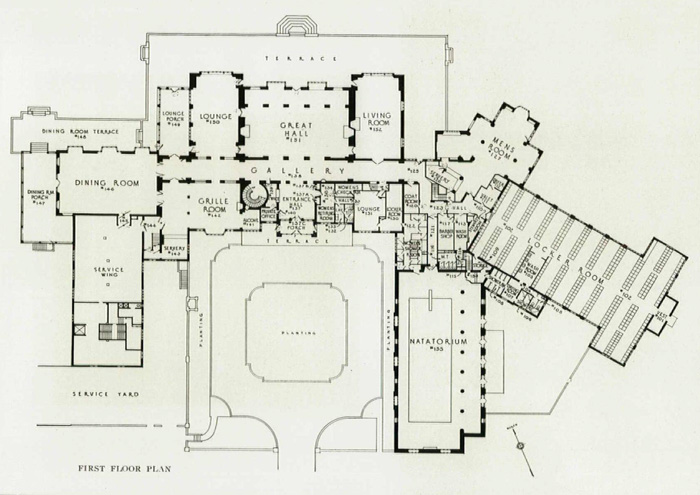

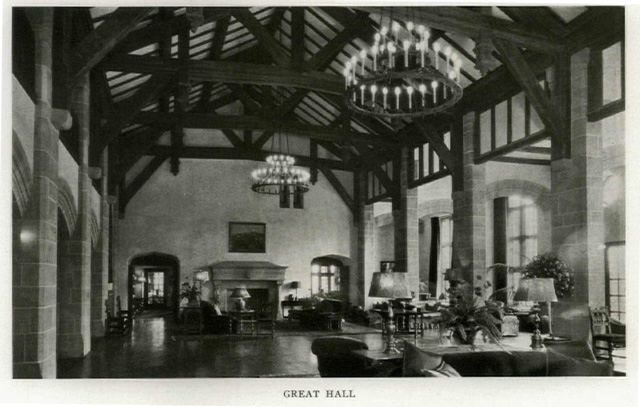
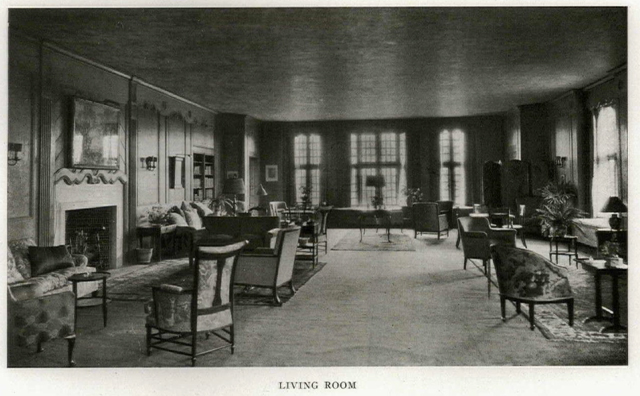
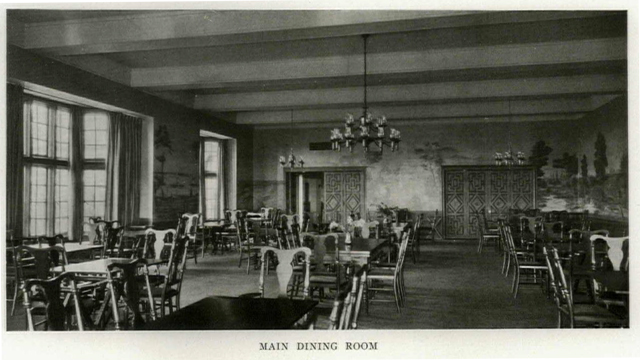
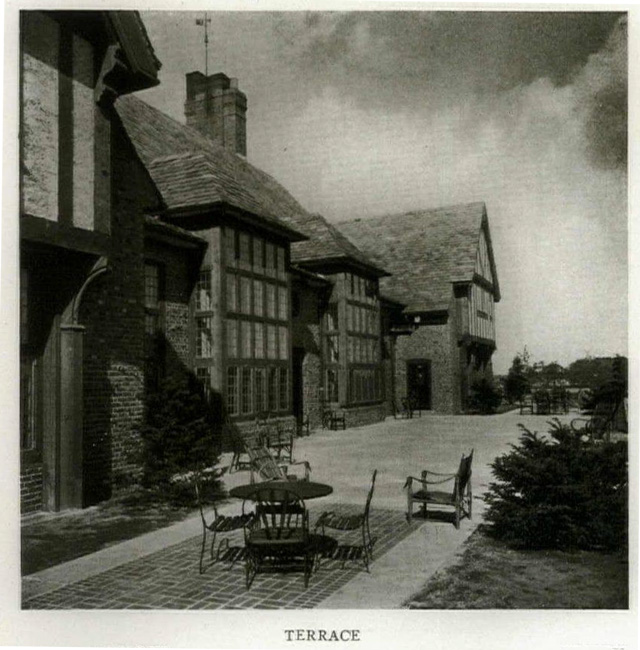
When the club was completed the first floor was also the location of a men’s room, a large locker room and the swimming pool (labeled a natatorium on the plans – borrowed from Late Latin “place for swimming” into English in New England in 1890). Photos courtesy of: Architectural Forum (March 1930).


The second floor was the location of several private dining rooms, the manager’s suite, multiple guest rooms, the library, the servants wing, a boys locker room along with the upper part of the great hall, the swimming pool, and the locker room. Photo courtesy of: Architectural Forum (March 1930).
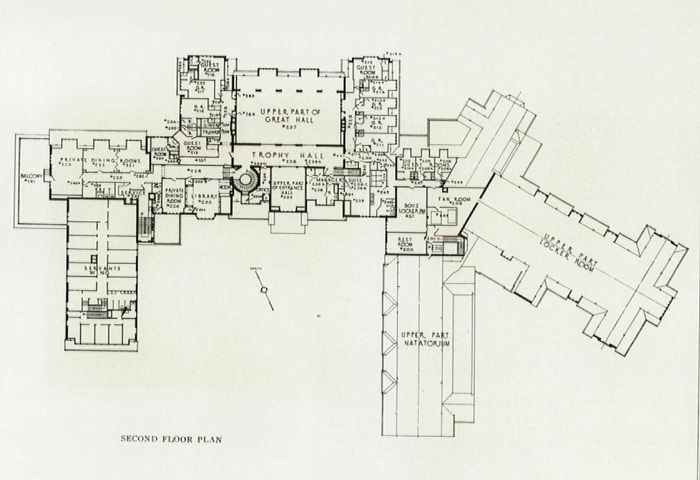
During the rebuild, it is reported “the members purchased the Hall Estate”. The world-renowned English firm of Colt & Allision was hired to redesign the course while summer play continued on the existing course. “The new course welcomed its first round on September 3, 1927.” Source: www.ccofd.com. Photo courtesy of: Architectural Forum (March 1930).

As with most of the private clubs in Grosse Pointe, the clubhouse has undergone several expansions and renovations over the years, however the integrity and beauty of the original structure, inside and out, has been retained. Image courtesy of CAM Magazine (October 2017) and Katie Doelle.
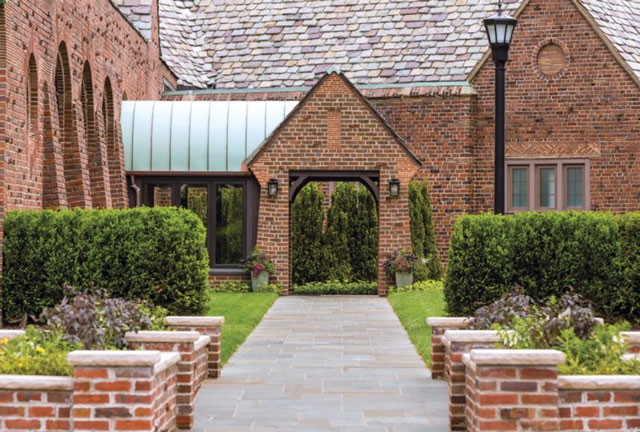
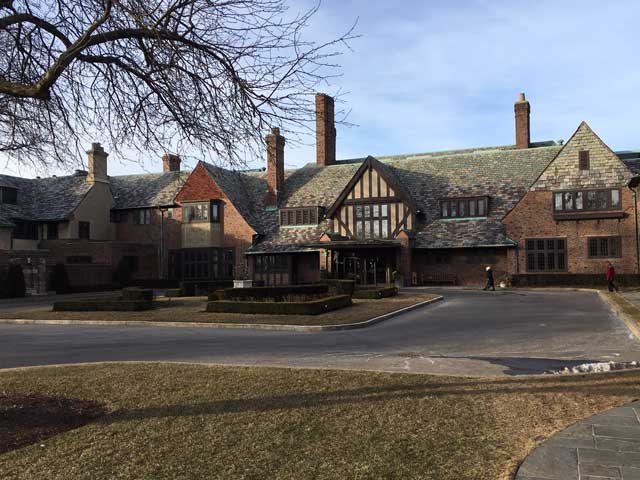
In the 1930’s, it is reported the pool was closed due to cost concerns during the Great Depression as well as concerns about water-borne polio. It was decided to cover the swimming pool area to install four lanes for bowling. When removing the swimming pool structure, it is reported “the club opted to create a lower level by excavating down five feet below the existing footings without disturbing the structural integrity and beauty of the historic building.” Source: CAM Magazine (October 1917). Since 1938, the area has been used exclusively for bowling.
In December 2016, the athletic wing was transformed to six lanes of state-of-the-art bowling, a two-level fitness center, children’s daycare room along with an updated men’s locker room, all of which can be accessed by an entrance on the side of the building. It is reported the renovation cost $6m. The goal – to ensure the Country Club of Detroit became the premier country club of Michigan and attract younger people year-round. It is safe to say that goal was achieved.Today the Country Club of Detroit is a pillar of the community.
*Photos courtesy of the Higbie Maxon Agney archives unless stated.
** Research, information, and data sources are deemed reliable, but accuracy cannot be fully guaranteed.
Written by Katie Doelle
Copyright © 2023 Katie Doelle
If you have a home, building or street you would like us to profile please contact Katie Doelle – ktdoelle@gmail.com – we will try and feature the property.

